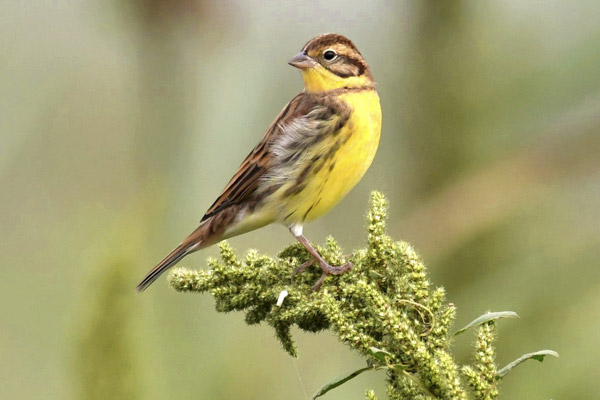
A yellow-breasted bunting rests on a plant. (Photo by NING FENG/FOR CHINA DAILY)
The once-abundant yellow-breasted bunting-often listed on menus as "rice bird"-has been reclassified as critically endangered on the red list of threatened species by the International Union for Conservation of Nature.
That is one step from the highest levels of "extinct in the wild" and "extinct".
Its decline has become extreme in the past decade, likely driven by excessive trapping at migration and wintering sites, according to the IUCN, which released the list on Tuesday.
The bird has long been considered a delicacy in southern China, especially in Guangdong province.
Although the Chinese government banned the hunting and selling of the bird in 1997, illicit trading has been rampant, driving the species to the verge of extinction.
Every year, yellow-breasted buntings migrate from Siberia to wintering grounds in South China and Southeast Asia, on a journey spanning up to 4,000 kilometers. On the way, they have become the target of poachers.
"The species migrates in huge flocks, which are hunted in massive numbers," according to a report from the international conservation organization Birdlife International. They also roost at night in large numbers, making them easy to trap.
Once restricted to a small area of southern China, rising affluence has increased demand for the rare delicacy, and now hunters have to travel widely to find sufficient birds, according to the IUCN.
A man surnamed Liu from the northern province of Hebei told Beijing Youth Daily that back in 2000, more than 400 yellow-breasted buntings could be captured in one net; and in 2008, he could still catch more than 50 birds in one day. But today, only one or two can be caught in a day.
Liu said bird hunting is a lucrative business: a net costs only 15 yuan ($2.30), while a yellow-breasted bunting can be sold for about 20 yuan.
Liu said that after the birds were captured, they would be put into cages to be fattened up for around 20 days. Then they would be suffocated in a sealed bag before being sold to South China.
According to bird protection volunteers, sales of the yellow-breasted bunting in Guangdong have gone underground in recent years as a result of the government's crackdown campaigns.
In some restaurants, where one yellow-breasted bunting is priced at up to 60 yuan, its name on the menu has been replaced with "rice bird" to avoid attention from authorities.
Despite its popularity among diners, the yellow-breasted bunting differs little from pigeons or quail in nutrition, said Zhu Yi, a food science professor with China Agricultural University. And as a migratory species, the birds may host unidentified viruses, and many illegally captured ones may be poisoned to death, threatening the health of diners, he said.
Media reports show there were 28 cases of illegal hunting of yellow-breasted bunting in China from 2000 to 2013. In one case, more than 100,000 birds were seized by authorities in Guangzhou and Shaoguan, Guangdong province.


















































